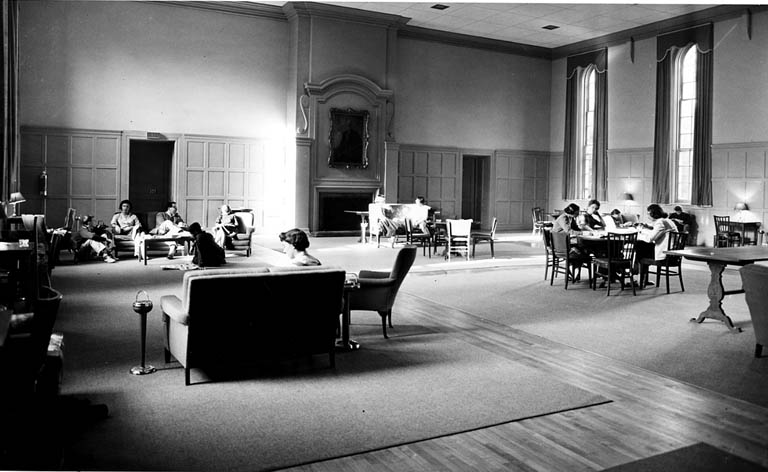
(photo courtesy Friends' Historical Library)
Parrish Commons, evening, 1947; students congregate with a jukebox,
ping-pong, cards, and conversation. "We went up every night after dinner
to play bridge", said Associate Dean Bob Gross, who attended Swarthmore in
the 1960s. "There was no other student center."

The CRC, evening, 1996: new white administrative offices surround partitions and empty lounge chairs.
Having served as everything from collection hall to the home of CIVIC and its constituent groups, the space underwent its most recent transformation this summer. The former Community Resource Center (CRC) is now administrative offices. The change was necessary because of the housing crunch caused by the high enrollment this year. Offices line the outside walls, and the center of the room has chairs and partitions.
"I really don't know what they will do the the middle of the room." said Dean Gross. "During the working day there are some limitations for its use."
"The administration does not want students to use that space, " said Edgar Lee, last year's CRC coordinator. "It is their meeting space."
Throughout the years, the room has served a variety of functions. From the time that Parrish was rebuilt after the great fire of 1881, until Clothier was built in the early 1930s, it was the college collection hall, with built-in seats and a balcony at its south end. After Clothier Hall was finished in 1931, the room was no longer used for collection. It remained empty for tow years, while the Board of Managers decided what to do with the space. Eventually, they "appropriated $3,000 for the remodeling , removing of seats, balcony and stage, and the installation of bookshelves, closet space, and the fireplace. Hand-made walnut furniture and copper lamps were bought for the lounge. The large map of the world of the south wall was obtained [later,] in 1940 from the League of Nations pavilion of the World's Fair." The room was used only for dances, parties, teas, and other special occasions for about a decade.
In the 1940s, the room because the social center of the College, known to the students as "Commons". It was "never empty from sunrise to well after sunset." On December 12, 1947, The Phoenix explained that "With the arrival of the Navy in the summer of 1943 there was mounting pressure for the establishment of a student commons. Various possible sites were considered, including Hall Gymnasium and the erection of a new building. But after consultation with the fire underwriters, permission was secured to allow smoking in Commons and this place was decided upon."
"It was during the spring semester of 1944 that 'Collection', as it was then called, first began to take on any real significance in the social life of the students. Up until then no smoking had been permitted in this room. AT that time too, the first booths and tablies were installed, as were the juke-box and the coke-machines. Gradually during the later war years other facilities were added: more chairs and tables, the p.a. system, and finally the store."
The use of the room declined with the completion of Sharples in the 1960s. Before Sharples was built, students ate their meals in what is now the Admissions Office, which meant that it was merely a flight of stairs from their dining tables to Commons. However, diring the SASS takeover the the Admissions office in January of 1969, SASS leaders addressed that national media from "Commons".
About four years ago the space because the CRC. "The Student Council wasted it as a center for the council, volunteer organizations, and other groups, for storage and meeting space," said Dean Gross.
These groups now meet in Bond, Parrish Parlors, or Kohlburg, but "they have lost their workplace and storage space, " said Lee. "Swarthmore has a definite need for a student center where people can meet and gather to share resources and ideas." Note: there are some great photos of Collection Hall around the turn of the century which should be added to this page. Also, there are photos of the map--it's quite nice.